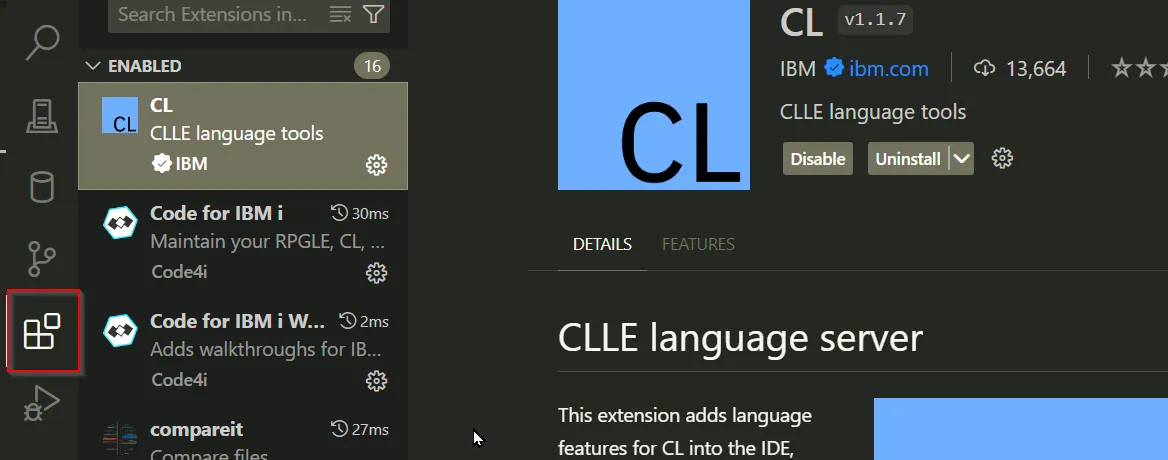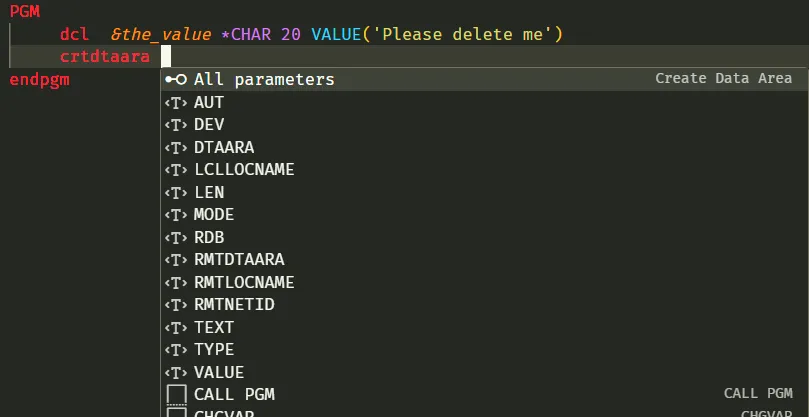Or it can be installed from the Extension view inside Visual Code.
Dette indhold er ikke tilgængeligt i dit sprog endnu.
Command Language is the scripting language for the IBM i operating system. This extension assists in CLP or CLLE program development, providing:
It also provides support for running a CL statement with Ctrl+r.
The CL Language tools extension can be installed from the Marketplace and is also part of the IBM i Development Pack .
Or it can be installed from the Extension view inside Visual Code.

Content Assist is triggered by Ctrl+space. This is best explained by examples.
Suppose you want to create a data area with the CRTDTAARA command. Enter CRTDTAARA follwed by a space, like this: 
Press Ctrl+space to invoke Content Assist to produce a pick list like this:

Press enter or tab to accept the highlighted “All parameters” from the pick list and a skeleton command is created: 
The cursors is in the first parameter value DTAARA. Enter the data area name, then press the tab key to move the cursor to the next parameter, TYPE: 
Press Ctrl+space to produce a pick list of valid types: 
Highlight *CHAR, then tab to move to the LENGTH parameter. Enter 20, then tab to VALUE. The value can be a text string or it can be a variable. UseCtrl+space to get a pick list of variables (just one in this example): 
Chose the variable. Delete the other unneeded parameter and you have a completed command: 
If you are familar with a command, you do not have to create a skeleton with all parameters. Suppose you have typed this far: 
When you type t a pick list of parameters that start with t is provided: 
If a pick list is too long, you can enter additional characters to reduce it. In this case, if you entered ty only TYPE would appear in the pick list.
Select TYPE and the cursor is in the type value field where you can do Ctrl+space to get a pick list of valid types: 
Prompting of most CL commands requires a connection to a server. However, there are a number of commands that are provided as snippets, which don’t require a connection. DCL, for example, is provided as a snippet.
Commands that are provided as snippets are preceeded by a “box”: ![]()
To declare a variable, enter just “d” and get a list of commands that begin with “d”:

Since the “DCL” command is highlighted, hit enter and get a pick list of available parameters:

The “VAR” parameter value is selected, so enter the variable name, then tab to the “TYPE” parameter value:

If all the valid valued for “TYPE” are know, just enter a valid value, for example “*CHAR”. Or delete the highlighted value and key Ctrl+Space to get a pick list of the valid values:

A CL command may be executed by highlighting the command and pressing Ctrl+r.
The two lines of the CRTMSGF command are highlighted:

Press Ctrl+r and success is reported:
Click Open output if you want more detail or if the command fails: 
Not all CL commands may be executed.